The Difference Between SEO Vs. SEM: How to Choose the Right Option For Your Brand

Table of Contents
- Understanding SEO and how it works
- Building Blocks in SEO
- What is SEM, and When Should You Use It?
- SEO Vs. SEM: Understanding the Similarities and Differences
- Pros and Cons of SEO
- Pros and Cons of SEM
- SEO Vs. SEM: Which is Better?
- Key Takeaways
- Conclusion
- FAQs
If you’re an entrepreneur looking to grow your business by reaching your target audience via search engines, you may be wondering which is better, SEO or SEM? While SEO improves your search engine ranks, SEM employs PPC ads and other sophisticated strategies to get more visitors from search engines to your site.
SEO and SEM are two separate marketing channels in increasing visibility. The key to success is identifying the best search engine approach for the outcomes you want to achieve.
Understanding SEO and How it Works
One of the essential strategies for organizations looking to increase visibility and generate traffic to their websites is search engine optimization (SEO). SEO is the process of gaining traffic from search engine results that are free, organic, editorial, or natural. Increased website traffic increases the likelihood that potential customers will visit your site.
The goal of SEO is your website’s ranking in search results on search engines like Google. When it comes to SEO, it’s all about using organic methods to get your website to the top of the search results.
SEO doesn’t necessitate that brands spend their advertising budgets on the first page of search results. Consequently, they use various techniques that encourage search engines to rank their content higher in the search engine results pages (SERPs).
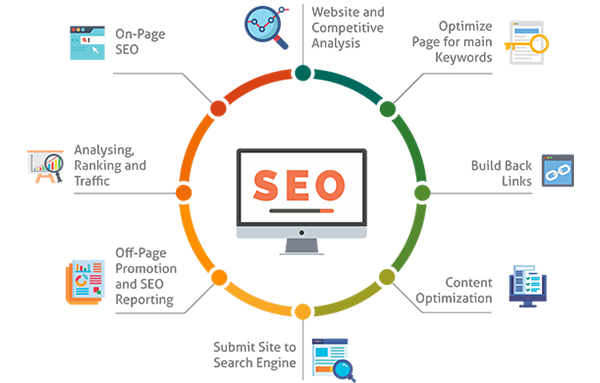
Building Blocks of SEO
Digital marketers need to stay on top of the ever-changing landscape of search engine optimization to keep their brands, websites, and businesses visible to potential customers. Even though SEO is constantly evolving in subtle ways, the field’s core concepts remain constant. There are three main pillars of SEO that you should be aware of and use daily.
1. On-page SEO
On-page SEO aims to increase a website’s visibility in search engine results for a specific term or phrase. These approaches have three main components: keyword research, content production, and optimization. Using on-page optimization in SEO may assist search engines in better grasping a page’s content and give it a higher search engine ranking.
2. Off-page SEO
A website’s reputation and authority are built via off-page SEO, connecting it to other high-quality online properties. Link building (acquiring high-quality backlinks from other websites) and updating local listings and directory profiles are two examples of off-page SEO tactics. Having many other websites link to a brand’s website demonstrates to search engines that the brand’s website is a credible source of trustworthy information.
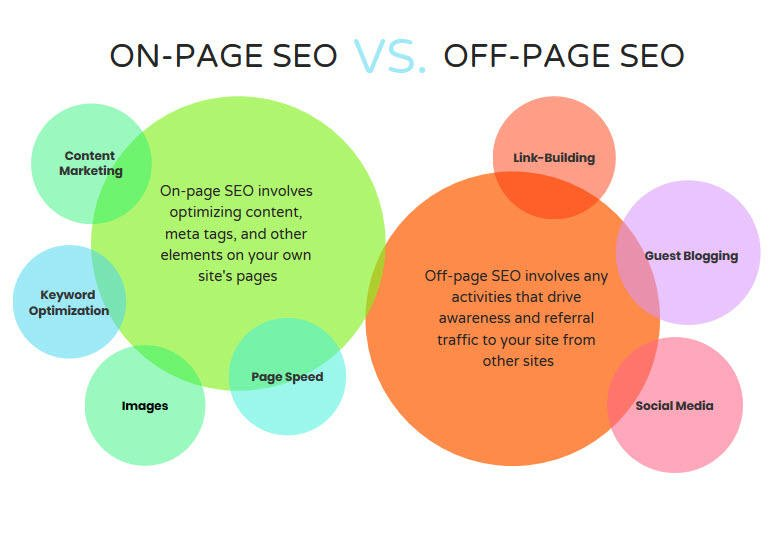
Both on-page and off-page SEO work together to improve your site’s user experience and search engine rankings by making it more user- and search engine-friendly. You’ll get a boost in search engine rankings if your website is friendly to both search engine crawlers and visitors.
3. Technical SEO
Rather than focusing just on a website’s content, technical SEO seeks to strengthen the site’s foundation and backend structure. Site performance, mobile-friendliness, indexing, crawlability, site design, structured data, and security are all addressed in these techniques. As a result of technical SEO, both users and search crawlers enjoy improved performance in the search results.
What is SEM, and When Should You Use It?
In search engine marketing (SEM), companies may use a variety of cutting-edge, paid approaches and strategies to boost their website’s visibility and authority in search results. SEM encompasses any strategy that improves your website’s visibility in search engine results pages and increases traffic to your website. Pay-per-click (PPC) advertising and paid advertising on Google-specific platforms like Google ads etc. are examples of SEM’s paid strategies to appear in search.
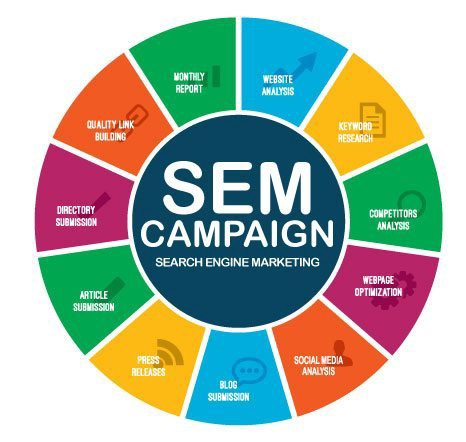
A paid SEM strategy involves creating and optimizing advertising and establishing a budget to cover the cost of ad placement. Your SEM results turnaround time might be affected by several variables. To improve your targeting and boost conversion rates, you may need to wait a few weeks before seeing returns from your SEM campaign.
SEM uses pay-per-click since marketers pay for impressions that result in traffic. If you want to get your message in front of the right people at the right time, search engine marketing is a great way to do so.
SEO Vs. SEM: Understanding the Similarities and Differences
It’s essential to note that SEM and SEO have different roles in search marketing. There’s a slight distinction between SEM focusing on employing paid techniques like PPC and SEO to deliver customers to your site. SEO focuses on improving a website’s ranking in search results.
The similarities
- The goal of both SEO and SEM is to have a brand appear prominently on search engine results pages (SERPs) and improve the visibility of a brand’s online presence.
- SEO and SEM both aim to increase a website’s visibility in search results, but driving visitors to a site is the primary objective. Each method applies different strategies to improve the number of people who click on the search results and boost the CTR.
- SEO and SME both aid in identifying and focusing on keywords that are relevant to your business. Both these strategies have keywords at their heart.
- Both SEM and SEO start with keyword research to find the best keywords to target. The research involves looking at keyword popularity to establish your target audience’s top keywords. It also entails researching keyword competition to determine what other firms are targeting the same phrases and figuring out how to compete.
- Neither SEO nor SME is a strategy you can put in place and forget about. To improve performance, both need ongoing testing, monitoring, and adjustment.
The Differences
- When a user clicks on a paid SEM result, your brand gets charged for each click. To use this PPC lead-generating strategy, you’ll need a certain amount of money set aside for SEM advertising. At the same time, you don’t pay anything if a user clicks on an SEO result.
- SEM and SEO-driven search results display on SERPs in a distinct format. If a paid ad is placed using SEM strategies, it may be easily recognizable as an advertisement, whereas organic SEO results are not.
- Successful SEO and SEM campaigns are based on a desire to reach a specific demographic, but only SEM allows you to pinpoint that demographic. SEM allows you to target specific demographics by establishing age, income, and other filters. SEO does not allow you to control who sees your search results.
- Ad extensions, which may contain extra links, phone numbers, and callouts, appear in SEM search results. On the other hand, SEO results may appear in search results with highlighted snippets.
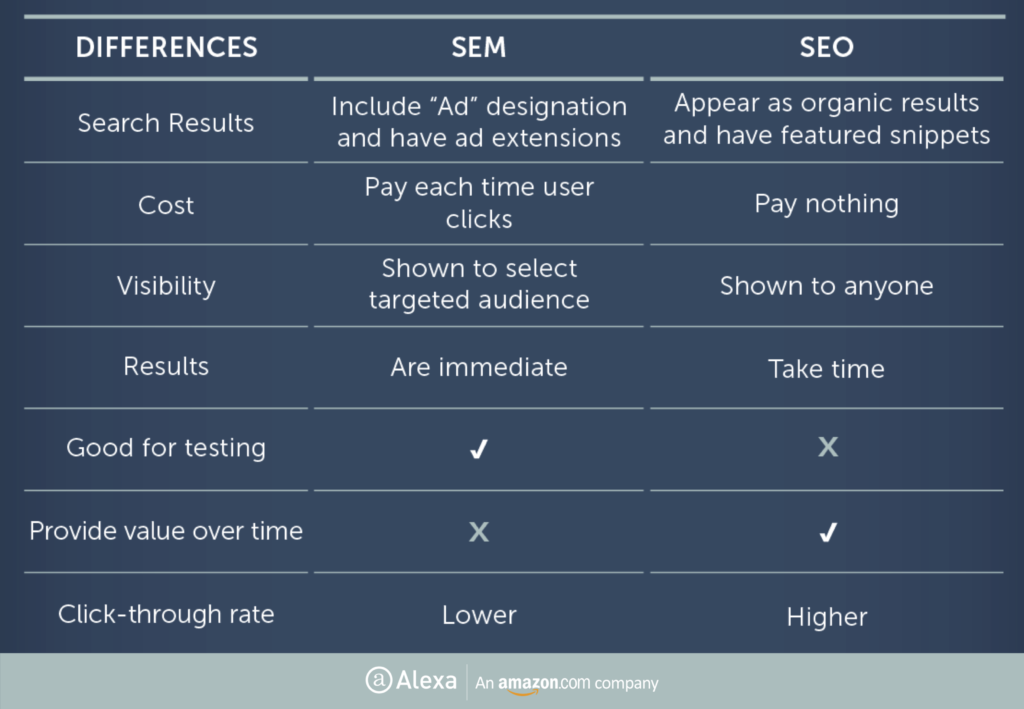
Pros and Cons of SEO
SEO has pros and cons, even though it is often regarded as one of the most effective strategies for achieving better rankings with Google.
Pros
- SEO is completely free of charge, and how much time you devote to researching keywords and incorporating them into your high-quality content is what determines how effective your efforts are.
- High SEO implies that your site is responsive, has excellent performance, and has no lag. It is also mobile-optimized.
- Your localized traffic may be improved by using technologies like Google My Business.
- A good SEO campaign is customer-centric and may help you attract new business. Their first impression is that you have a well-designed website. No grammatical mistakes have been found in your writing. You’re utilizing cutting-edge software on a safe website, so they must discover the purchase button.
- Your website is authoritative if you use the most acceptable SEO tactics. A single article is all you have for each term, and only high-quality backlinks are coming in.
Cons
- SEO is dynamic and may alter at any time. You might be at the top of the search results one day, and the next day, your site will have been severely degraded.
- Competitors continuously seek competing SEO results. Your competitors are always on the hunt for a slice of your high-ranking SEO pie, so you need to be constantly vigilant.
- SEO is a long-term investment that pays off only gradually. Changes to your website and adherence to industry best practices might take months to impact.
- You may not notice a performance increase no matter how often you update your website’s content and functionality. SEO has no assurances.
- You must continually be on top of your game, which may necessitate a costly outlay. For example, if a website isn’t responsive, it will be penalized.
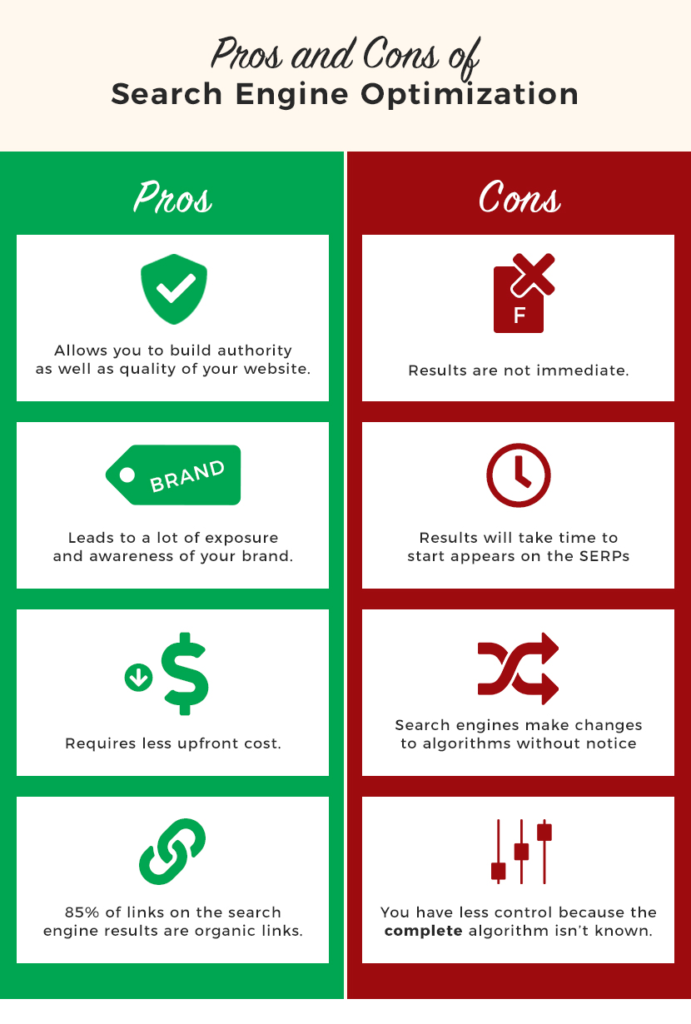
Pros and Cons of SEM
Undoubtedly, SEO is a valuable tool for practically all companies. Examining its benefits and drawbacks might help choose whether and how to utilize it.
Pros
- Using the analytics tool, you can track your progress in real-time and make adjustments as necessary.
- When you use Google Ads, you can keep track of your campaign’s development in great detail. SEM is exceptionally quantifiable. You may also utilize the analytics integration to confirm that everything is running well.
- SEM has a wide range of segmentation options. By concentrating on keywords, you’ll be able to get your message out to the people who are actively interested in it. You may narrow your search by location, language, and behavior.
- SEM is suitable for both big and small businesses since the investment in budgetary resources is scalable. Getting to the top of the search engine results is a race against everyone else.
- Pay per click only charges you if your ad successfully brings in customers. Setting a maximum daily budget and per-click price limit is an option. This approach ensures the campaign’s financial success.
- SEO or content marketing takes time and effort to see returns; however, SEM fetches relatively faster results.
Cons
- Paying for SEM is the only way to get results. Your long-term costs will rise even if your campaigns become better over time and your cost per click decreases.
- In contrast, compared to native advertising, SEM entails “invading” the user’s area with content that they didn’t seek out. Ad blockers might prevent your adverts from seeing the users you’re trying to reach.
- There is a lot of competition for keywords in search engine marketing. Many organizations are vying for the same spots, raising costs and making it harder to achieve a fair return on investment.

SEO Vs. SEM: Which is Better?
Your marketing campaign’s objectives will determine the answer to the “SEO or SEM, which is better” query. Ideally, you’d have an SEO strategy that is part of a more considerable SEM effort.
Absolutely nothing compares to SEM when it comes to driving traffic and advertising in near-real-time. On the other hand, SEO is primarily concerned with collecting organic (ad-free) traffic, monitoring, and optimizing it.
As part of your remarketing strategy, you’d have PPC campaigns that target a wide range of demographics, as well as hyper-targeted local advertisements that target customers near your brick-and-mortar sites.
Yes, you may choose SEO or SEM. Some companies begin with SEM strategies, then shift to SEO later on. Some companies merely use SEO, while others devote their resources to search engine marketing (SEM).
As soon as you combine SEO with PPC, you’ll see a significant increase in the quality of your traffic. However, you’ll need to consider your budget, goals, and KPIs before creating a strategy that works.
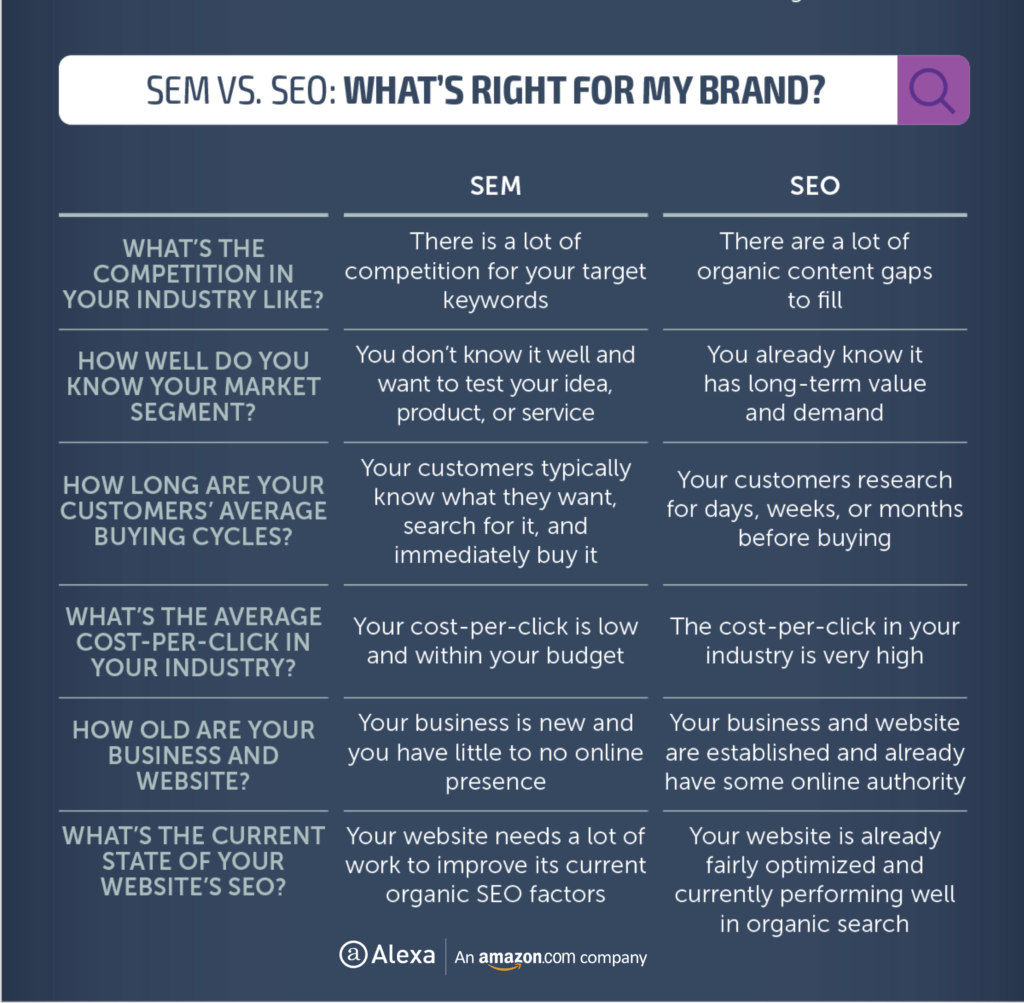
Key Takeaways
- Businesses may utilize SEO and SEM to reach their target audiences on search engines by using two separate marketing channels, sometimes interchangeably.
- SEO is a critical strategy for brands that want to boost their online presence and website traffic. It’s challenging to manage SEM without comparing or integrating SEO.
- Despite their similarities, these are two independent approaches for increasing search engine exposure.
- SEM focuses on focused traffic you have to pay for, whereas SEO focuses on free or low-cost traffic.
- SEM and SEO can coexist, but only if the website is SEO-friendly.
Conclusion
SEO and SEM assist you in getting your websites or online enterprises to show up on search engine results pages. SEO is the way to go; otherwise, SEM works well if you’re looking for immediate results and don’t mind spending money on PPC advertisements. Whether via SEM or SEO, traffic from search engines may be difficult to come by. The best way to deal with SEO and PPC is to work with a digital marketing company that can handle both.

FAQs
SEO is free and depends on organic search strategies, while SEM costs money and relies on advertising.
Ideas and themes that describe what your content is about are called keywords.
Search engine marketing combines PPC, Local SEO, and Organic SEO.
Investing in SEM may help your SEO efforts and enhance website traffic. In short, SEO and SEM complement each other.
SEM focuses on targeted paid advertising, whereas SEO focuses on growing organic site traffic. Both depend on intelligent keyword usage, concentrate on website traffic flow, and complement other digital marketing operations.
Latest Blogs
Explore how Google’s 2025 AI search updates triggered ranking chaos. Learn actionable strategies to adapt your SEO for AI Overviews, zero-click searches, and SERP volatility. Stay ahead now.
Learn how to rank on AI search engines like ChatGPT, Perplexity, and Gemini by optimizing your content for authority, structure, and relevance. Stay ahead in AI-driven search with this strategic guide.
Explore the best healthcare SEO services for your medical practice. Improve online visibility and effectively reach more patients in need of your services.
Get your hands on the latest news!
Similar Posts

Artificial Intelligence
6 mins read
The Role of AI in Digital Marketing: AI Article Generators Transforming Content Creation

Artificial Intelligence
4 mins read
How AI Content Creator Is Shaping the Future of Digital Content

Digital Marketing
3 mins read